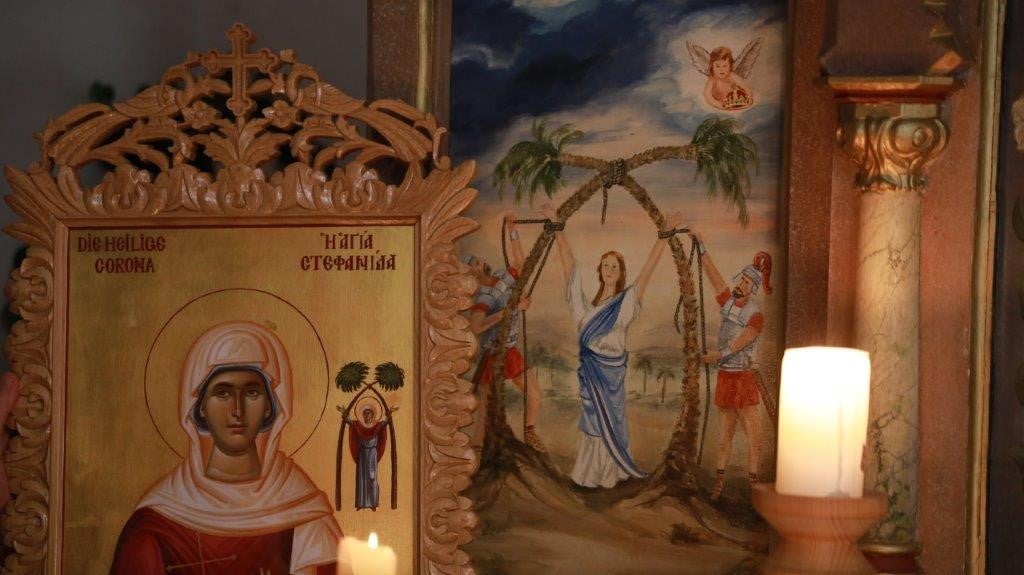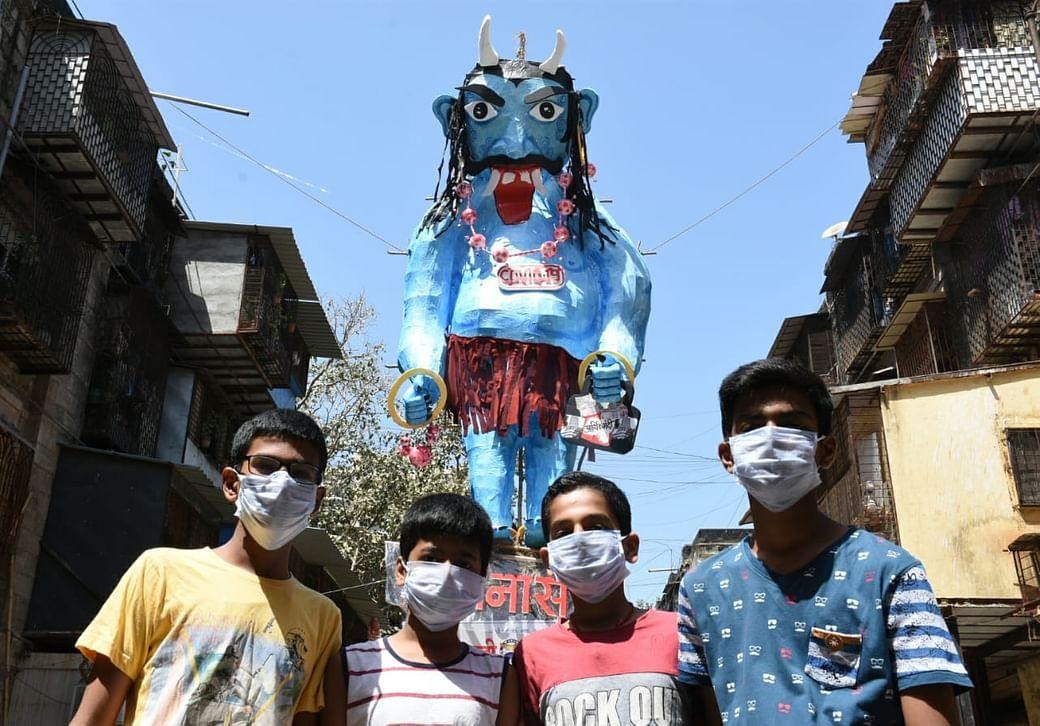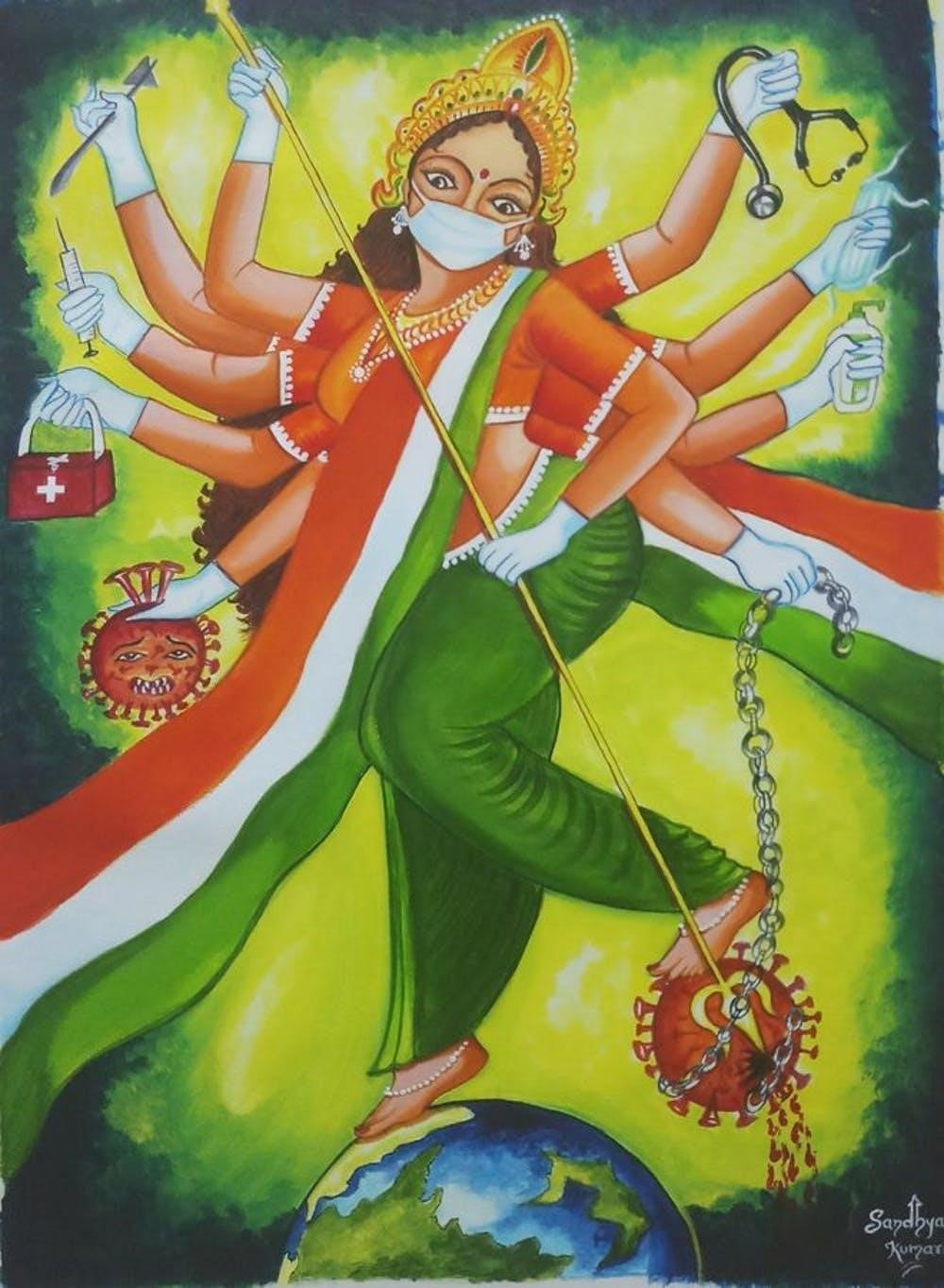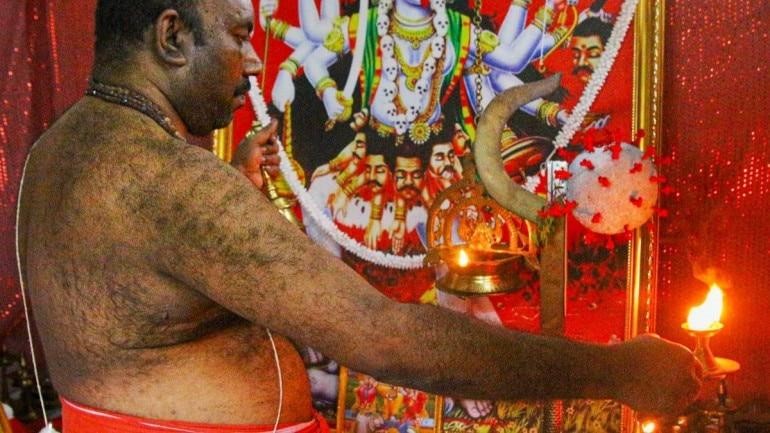Saint Corona, CoronAsur, and Corona Devi: New Embodiments of the Relationship between Religion and Disease
contributed by Natalie Lang, 3 July 2020
Saint, demon, and goddess – we seem to be at the mercy of Corona. The relation between religion and health probably dates back longer than both these terms exist, and pandemics have marked particular moments of this historical connection. Hagiographic accounts and oral narratives about divine forms from different parts of the world are testimony of this historical relationship, wherein saints and gods often need to adapt their realms of action to new challenges.
As an anthropologist with fieldwork experience in La Réunion, where the veneration of saints, gods, and spirits is part of many people’s everyday life, I am familiar with historical developments of saints and goddesses that often seem closely linked to regional circumstances. For example, since Notre Dame de la Salette is said to have protected a parish and ultimately the whole island from cholera in 1859, her annual pilgrimage attracts thousands of people. I would not have expected to witness the creation of saints, demons, and goddesses so closely myself as such a fast and global phenomenon.
Saint Corona
Saint Corona is said to have been removed from the Catholic calendar of saints and forgotten, to experience a recent comeback in 2020 since she shares her name with the crown-wearing virus. Saint Corona is sometimes depicted with her two deathly palm trees to which she was tied when they were bent down to tear her apart when bouncing up. She became a martyr at the age of 16 for comforting the soldier Victor while he was tortured because of his Christian faith in places ranging from Syria to Italy, depending on the sources, at unknown date around the first to fourth century. Nothing about Corona is certain.
Elizabeth Harper traces claims about Corona as saint of epidemics to a controversial right-wing Catholic website in March 2020, which spread to other Catholic and secular media channels in less than a week. Newly added information on Wikipedia remarks that Saint Corona is worshiped in connection with the pandemic since March 2020. While Corona shares a Wikipedia entry in English and 12 other languages with Saint Victor, she has her own Wikipedia entry in fewer languages, one of the most detailed being in German at the time I write this post.
Saint Corona is increasingly well known in Germany. Her sudden popularity led to a fast restoration and exhibition of a reliquary shrine in the Aachen Cathedral, which had initially been planned for later this summer. Although I have been to the Cathedral as a child when visiting relatives in Aachen, we only had eyes for Charlemagne, who had been buried there in 814, while we were unaware of a certain Corona at the time. In 2020, Corona’s story went through national news and social media platforms (ZDF, Tagesschau).
Bloggers and Facebook users discuss whether 14 May or 20 February of the Gregorian calendar, or 11 November of the Orthodox Church calendar is Saint Corona’s most important day. Some social media users doubt the sources that provide historical information about Corona, such as the ecumenical encyclopedia of saints (Ökumenisches Heiligenlexikon). And they are divided about the compatibility of the various realms of action attributed to Corona, which include money, treasure-hunting, gambling, and disease. These realms seem to perfectly fit the close relation between the world health and economic crisis caused by COVID-19.
Places of worship receive sudden attention, such as a Corona chapel in the woods near Arget in the south of Munich, which its pastor had not thought to become so important one day. While this year’s saint’s day celebrations were closed to the public for safety reasons, the pastor already looks forward to having a procession and service on 14 May 2021 (Tanja Bergold).

A newly painted Corona ikon (left) in the Corona chapel near Arget, May 2020. Credit: Tanja Bergold
The picture above shows (on the left) a newly painted ikon of Corona to be donated by a Greek Orthodox archpriest to this Corona chapel in Bavaria. The painting on the chapel’s shrine in the background also deserves attention. On the 1004 pages of my late great-grandmother’s book of saints (Das Leben der Heiligen by P. Otto Bitschnau [1881]), wherein I could not find Corona, the saints are depicted with a halo, which they also wear already during their cruel processes of dying, and only those of royal blood wear crowns in addition to halos. On the shrine’s painting in the Bavarian chapel, Corona, being attached to the palm trees by two Roman soldiers, does not have a halo. Instead, an angel floats above her with a crown in its hands, which I assume to illustrate one of the two crowns that Corona saw descending from heaven in a vision, for Victor and herself.
Sankt Corona am Wechsel, a small municipality in Austria with a parish and pilgrimage church dedicated to Saint Corona, has also received recent attention. Past venerations of the patron saint in the Austrian parish to protect the livestock against animal diseases do not assuredly explain the recent veneration of Saint Corona in relation to the pandemic. Rather, Corona exemplifies the possibilities of adapting saints to historical, regional, and global circumstances.
CoronAsur and Corona Devi
Around the same time when Saint Corona was connected with the virus on Wikipedia, a demon called CoronAsur was burned during the Holi festival in Mumbai in March 2020. CoronAsur entails the word asura for demon. This demon, after whom we named our blog, has inspired diverse forms of art in India, including dance, songs, and scroll paintings (Carola Lorea).

CoronAsur effigy in Mumbai, March 2020. Credit: BL Soni, The Free Press Journal
The personification and depiction of the virus as a demon made of paper and other materials renders the threatening yet invisible coronavirus visible, tangible, and, we can only hope, attackable. Rashmi Shetty describes the creation of the CoronAsur effigies in Mumbai as a double-layered Latourian iconoclash in that it both replaces the traditional Holika demon with CoronAsur and then destroys this one, too.
Whereas CoronAsur was burned, goddesses like Mariamman, Shitala, or Sansari are venerated for protection against the virus in different parts of South Asia, some being called Corona Maa/Mai or Corona Devi (the suffixes meaning mother and/or goddess). Yet, these goddesses usually have both benevolent and maleficent sides. Furthermore, associations of disease with demonic and godly figures can cross boundaries between evil and divine, as exemplified in the transformation of Hariti from demoness to goddess in Buddhist and Hindu traditions, where she is associated with children and diseases that afflict children, such as smallpox (Sree Padma, Adrija Roychowdhury).

“Maa Bharati on Coronavirus”, 2020. Credit: Artist Sandhya Kumari, reproduced by The Conversation
Crossing Boundaries
Demonic or divine embodiments of diseases in different parts of the world reveal an intrinsic yet double-sided relationship between religion and disease. In Ghana, “Sakpata is smallpox, but by serving Smallpox as a deity its priests have the possibility to employ the disease in a dosed manner” (Birgit Meyer). The Chickenpox-related deity Chankpana in Ghana is said to spread and cross national boundaries like the virus (Samuel Aniegye Ntewusu and Samuel N. Nkumbaan). Corona Devi in the form of a thermocol ball venerated in a shrine in South India (picture below) equally illustrates the intrinsic relationship between the divine and the virus.

Corona Devi in the form of a thermocol ball with red crown-like spikes, June 2020. Credit: Press Trust of India
Hindu goddesses who are generally venerated for health issues are also associated with different realms of action that go beyond contagion and that emerge as important in particular places over time (Tulasi Srinivas). Furthermore, Hindu goddesses are sometimes assimilated with divine or holy figures from other traditions, such as Christian saints (Alexander Henn). In my own research context in La Réunion, some Indian indentured laborers and their descendants have joined the above mentioned celebrations for Notre Dame de la Salette since the nineteenth century, some associating her with the goddess Mariamman. There are more such mutual associations between Hindu, Catholic, and other gods, saints, and spirits, and I am eager to see whether new assimilations across religious traditions are made in the age of corona.
Religious boundaries are made by practitioners, religious leaders, politicians, and scholars. In addition to reaching across religious denominations, Corona, in its viral and supernatural forms, embodies good and bad, divine and evil, health and illness, religion and science, and other assumed contrastive pairs by at once crossing and sometimes reinforcing their boundaries.

Natalie Lang is a Postdoctoral Fellow at both the Asian Urbanisms Cluster and the Religion and Globalisation Cluster at the Asia Research Institute, National University of Singapore. Her research interests include religion, urbanity, migration, and diaspora in La Réunion, South Asia, Singapore, and Paris.
Disclaimer: The views and opinions expressed in this article are those of the authors and do not necessarily reflect the position of the blog editorial team or the Asia Research Institute.
South Asia | Southeast Asia | East Asia | Other Places | Hinduism | Buddhism | Islam | Christianity | Other Religions



